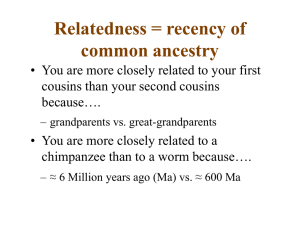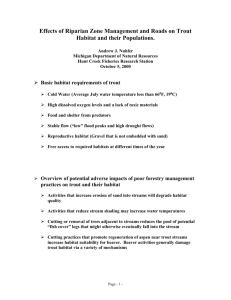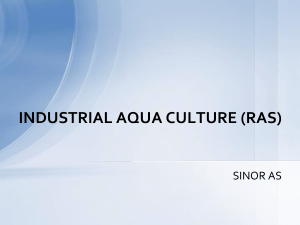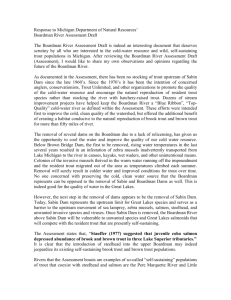F-35-R, Michigan - Michigan Department of Natural Resources
advertisement
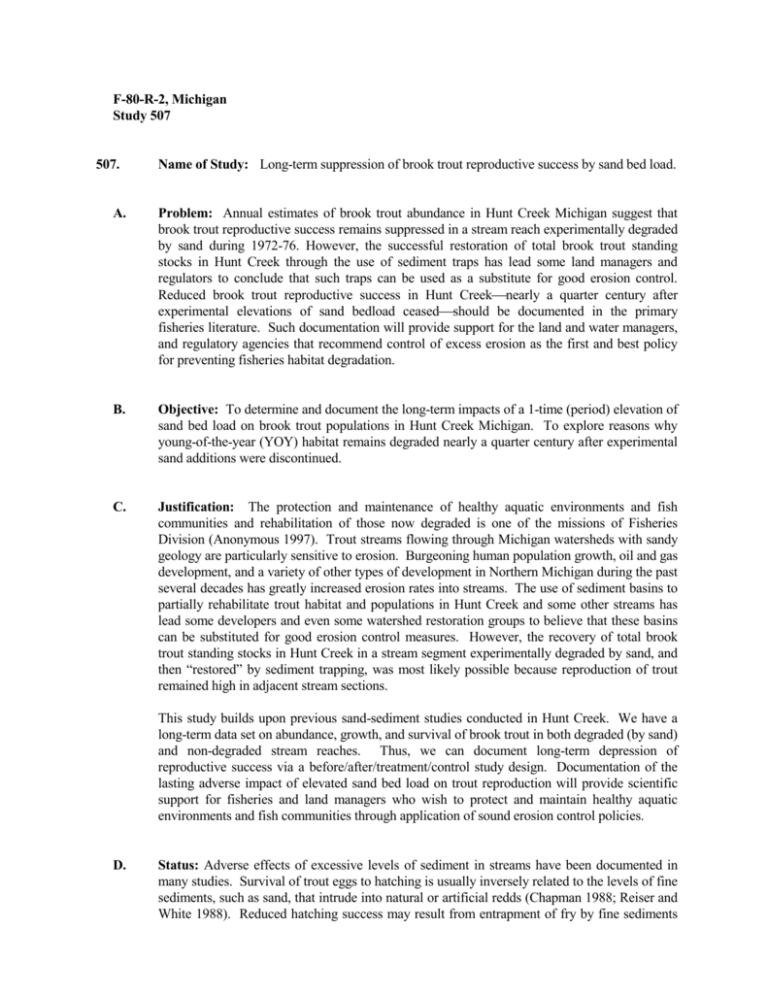
F-80-R-2, Michigan Study 507 507. Name of Study: Long-term suppression of brook trout reproductive success by sand bed load. A. Problem: Annual estimates of brook trout abundance in Hunt Creek Michigan suggest that brook trout reproductive success remains suppressed in a stream reach experimentally degraded by sand during 1972-76. However, the successful restoration of total brook trout standing stocks in Hunt Creek through the use of sediment traps has lead some land managers and regulators to conclude that such traps can be used as a substitute for good erosion control. Reduced brook trout reproductive success in Hunt Creeknearly a quarter century after experimental elevations of sand bedload ceasedshould be documented in the primary fisheries literature. Such documentation will provide support for the land and water managers, and regulatory agencies that recommend control of excess erosion as the first and best policy for preventing fisheries habitat degradation. B. Objective: To determine and document the long-term impacts of a 1-time (period) elevation of sand bed load on brook trout populations in Hunt Creek Michigan. To explore reasons why young-of-the-year (YOY) habitat remains degraded nearly a quarter century after experimental sand additions were discontinued. C. Justification: The protection and maintenance of healthy aquatic environments and fish communities and rehabilitation of those now degraded is one of the missions of Fisheries Division (Anonymous 1997). Trout streams flowing through Michigan watersheds with sandy geology are particularly sensitive to erosion. Burgeoning human population growth, oil and gas development, and a variety of other types of development in Northern Michigan during the past several decades has greatly increased erosion rates into streams. The use of sediment basins to partially rehabilitate trout habitat and populations in Hunt Creek and some other streams has lead some developers and even some watershed restoration groups to believe that these basins can be substituted for good erosion control measures. However, the recovery of total brook trout standing stocks in Hunt Creek in a stream segment experimentally degraded by sand, and then “restored” by sediment trapping, was most likely possible because reproduction of trout remained high in adjacent stream sections. This study builds upon previous sand-sediment studies conducted in Hunt Creek. We have a long-term data set on abundance, growth, and survival of brook trout in both degraded (by sand) and non-degraded stream reaches. Thus, we can document long-term depression of reproductive success via a before/after/treatment/control study design. Documentation of the lasting adverse impact of elevated sand bed load on trout reproduction will provide scientific support for fisheries and land managers who wish to protect and maintain healthy aquatic environments and fish communities through application of sound erosion control policies. D. Status: Adverse effects of excessive levels of sediment in streams have been documented in many studies. Survival of trout eggs to hatching is usually inversely related to the levels of fine sediments, such as sand, that intrude into natural or artificial redds (Chapman 1988; Reiser and White 1988). Reduced hatching success may result from entrapment of fry by fine sediments F-80-R-2, Study 507 - 2 that plug interstices in redd gravels or may result from low oxygen levels caused by poor circulation of water into redd pockets (Wickett 1954; Sowden and Power 1985). Rigorous field studies of sand-sediment effects on trout populations were conducted in both Poplar and Hunt Creeks during the 1970’s and 1980’s. Sediment trapping significantly increased fall abundance of age-0 brown and rainbow trout and age-1 brown trout in Poplar Creek treatment zones (Alexander and Hansen 1983). By contrast, young-of-the-year (YOY) brook trout abundance in a section of Hunt Creek experimentally degraded by elevating sand bed load did not recover within 10 years after sand additions were discontinued (Alexander and Hansen 1986; Alexander and Hansen 1988). Older age classes of brook trout in Hunt Creek were restored to pre-sand-treatment levels. Brook trout population data for Hunt Creek have been collected during each April and September since the last analysis made by Alexander and Hansen. Preliminary analyses of these new data indicate that historic YOY brook trout abundance in portions of the degraded zone have not been achieved nearly a quarter century since sand additions ceased. This occurred even though multiple sediment basins were maintained from 1982 until about 1995. Alexander and Hansen (1988) reported that although sediment basins restored the general channel morphology of the degraded zone to its pretreatment condition, sand-imbedded gravels were not completely cleansed and nursery habitat for YOY brook trout was not fully restored. We wish to explore reasons why young-of-the-year (YOY) habitat remains degraded nearly a quarter century after experimental sand additions were discontinued. It is probably not possible to duplicate measurements of many of the channel morphology parameters quantified during the earlier studies. Elevation benchmarks established at 100-foot intervals along approximately 2 miles of stream nearly 30 years ago probably can not be relocated or used. Wooden, 2-inch by 2-inch stakes driven into the stream bottom and at the banks were used to assess changes in bed and water surface elevation changes. Most of these stakes have disappeared. We may be able to obtain comparable data on some stream morphology parameters such as stream width. It will also be feasible to explore differences in channel morphology and substrate in reference zones where contemporary reproduction levels are similar to historic levels with values in the degraded zone. Literature Cited: Alexander, G. R., and E. A. Hansen. 1983. Sand sediment in a Michigan trout stream Part II. Effects of reducing sand bedload on a trout population. North American Journal of Fisheries Management 3:365-372. Alexander, G. R., and E. A. Hansen. 1986. Sand bed load in a brook trout stream. North American Journal of Fisheries Management 6: 9-23. Alexander, G. R., and E. A. Hansen. 1988. Decline and recovery of a brook trout stream following an experimental addition of sand sediment. Michigan Department of Natural Resources, Institute for Fisheries Research Report 1943, Ann Arbor. Anonymous. 1997. Strategic Plan-May 1997 draft. Resources, Fisheries Division, Lansing. Michigan Department of Natural Chapman, D. W. 1988. Critical review of variables used to define effects of fines in redds of large salmonids. Transactions of the American Fisheries Society 117:1-21. F-80-R-2, Study 507 - 3 Reiser , D. W., and R. G. White. 1988. Effects of two sediment size-classes on survival of steelhead and chinook salmon eggs. North American Journal of Fisheries Management 8:432-437. Sowden, T. K., and G. Power. 1985. Prediction of rainbow trout embryo survival in relation to groundwater seepage and particle size of spawning substrates. Wickett, P. W. 1954. The oxygen supply to salmon eggs in spawning beds. Journal of the Fisheries Research Board of Canada 11:933-953. E. Procedure: Channel morphology and substrate composition will be characterized within a 2mile reach of Hunt Creek, Montmorency County, Michigan. If possible we will obtain measurements comparable to those made in past studies. If this is not possible, we will assess differences in habitat quality in zones where reproduction levels have recovered to levels in zones that remain impaired. If heavy canopy cover permits, we will establish new and permanent transects using differentially corrected GPS. We will use mark-and-recapture methods to estimate trout populations during April and September each year of the study. Scale samples collected at the time of mark-and-recapture sampling will be used to determine the age composition of the population and individual growth rates. In addition we will determine brook trout length/weight relationships from a subsample of fish collected during each sampling period. These data will be collected from both the treatment and control sections. Job 1. Channel morphology will be characterized during low-flow periods during the first and second years of the study. Exact methods will be based, in part, on the feasibility of replicating historic measurements. Job 2. Estimate brook trout populations, age composition, growth rate and condition, and mortality rate of trout in 4 sections of Hunt Creek during April and September. Job 3. Analyze data and write progress and final reports. Job 4. Publish report through the Fisheries Division's editing and finishing process for Research and Technical reports. G. Geographical Location: Hunt Creek Fisheries Research Station, Lewiston, Michigan. H. Personnel: Andrew J. Nuhfer, and Todd C. Wills Research Biologists; Thomas J. Adams Fisheries Technician; Contract Editor, University of Michigan, Ann Arbor; and Research Administrative personnel, Ann Arbor.


